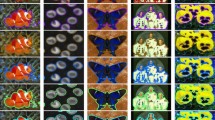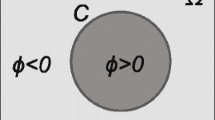Abstract
In this article, we present a new multi-phase pseudo 0.5 level set framework on fuzzy energy based active contour model to segment images into more than two regions. The proposed method is a generalization of fuzzy active contour based on 2-phase segmentation (object and background), developed by Krinidis and Chatzis. The proposed method needs only log2n pseudo 0.5 level set functions for n phase piece-wise constant case. In piece-wise smooth case, only two pseudo 0.5 level set functions are sufficient to represent any partition based on ‘the four colo theorem. The proposed fuzzy active contour model can segment images into multiple regions instead of two regions (object and background) based on curve evolution. In this article, instead of solving the Euler-Lagrange equation, a multi-phase pseudo 0.5 level set based optimization is proposed to speed up the convergence. Finally, the proposed method is compared with state-of-the-art techniques on several images. Analysis (both qualitative and quantitative) of the results concludes that the proposed method segments images into multiple regions in a better way as compared to the existing ones.






Similar content being viewed by others
Notes
References
Alpert S, Galun M, Brandt A, Basri R (2011) Image segmentation by probabilistic bottom-up aggregation and cue integration. IEEE Trans Pattern Anal Mach Intell 34(2):315–327
Appel K, Haken W (1977) . Ill J Math 21(3):429–490
Arbelaez P, Maire M, Fowlkes C, Malik J (2010) Contour detection and hierarchical image segmentation. IEEE Trans Pattern Anal Mach Intell 33(5):898–916
Bae E, Tai X C (2009) Graph cut optimization for the piecewise constant level set method applied to multiphase image segmentation. In: International conference on scale space and variational methods in computer vision, pp 1–13. Springer
Bezdek J C (1981) Pattern recognition with fuzzy objective function algorithms. Kluwer Academic Publishers
Cai W, Chen S, Zhang D (2007) Fast and robust fuzzy c-means clustering algorithms incorporating local information for image segmentation. Pattern Recogn 40 (3):825–838
Caselles V, Catté F, Coll T, Dibos F (1993) A geometric model for active contours in image processing. Numer Math 66(1):1–31
Caselles V, Kimmel R, Sapiro G (1997) Geodesic active contours. Int J Comput Vis 22(1):61–79
Chan T F, Vese L A (2001) Active contours without edges. IEEE Trans Image Process 10(2):266–277
Cremers D, Rousson M, Deriche R (2007) A review of statistical approaches to level set segmentation: Integrating color, texture, motion and shape. Int J Comput Vis 72(2):195–215
Dubrovina-Karni A, Rosman G, Kimmel R (2015) Multi-region active contours with a single level set function. IEEE Trans Pattern Anal Mach Intell 37(8):1585–1601
Fox C W (1988) An introduction to the calculus of variations. Dover Publications Inc
Gong M, Liang Y, Shi J, Ma W, Ma J (2013) Fuzzy c-means clustering with local information and kernel metric for image segmentation. IEEE Trans Image Process 22(2):573–584
Gonzalez R F, Woods R E (2008) Digital image processing, Pearson Education, Singapore
He L, Osher S (2007) Solving the chan-vese model by a multiphase level set algorithm based on the topological derivative. In: International conference on scale space and variational methods in computer vision, pp 777–788. Springer
Kass M, Witkin A, Terzopoulos D (1988) Snakes: Active contour models. Int J Comput Vis 1(4):321–331
Krinidis S, Chatzis V (2009) Fuzzy energy-based active contours. IEEE Trans Image Process 18(12):2747–2755
Krinidis S, Chatzis V (2010) A robust fuzzy local information c-means clustering algorithm. IEEE Trans Image Process 19(5):1328–1337
Krinidis S, Krinidis M (2012) Fuzzy energy-based active contours exploiting local information. In: 8th International conference on artificial intelligence applications and innovations (AIAI’12), pp 27–30
Li C, Kao C Y, Gore J C, Ding Z (2008) Minimization of region-scalable fitting energy for image segmentation. IEEE Trans Image Process 17(10):1940–1949
Li C, Xu C, Gui C, Fox M D (2010) Distance regularized level set evolution and its application to image segmentation. IEEE Trans Image Process 19(12):3243–3254
Liu W, Shang Y, Yang X (2013) Active contour model driven by local histogram fitting energy. Pattern Recogn Lett 34(6):655–662
Lucas B C, Kazhdan M, Taylor R H (2012) Multi-object spring level sets (muscle). In: International conference on medical image computing and computer-assisted intervention, pp 495–503. Springer
Martin D, Fowlkes C, Tal D, Malik J, et al. (2001) A database of human segmented natural images and its application to evaluating segmentation algorithms and measuring ecological statistics. In: International conference on computer vision (ICCV), vol 2, pp 416–423
Mondal A, Ghosh S, Ghosh A (2016) Robust global and local fuzzy energy based active contour for image segmentation. Appl Soft Comput 47:191–215
Mondal A, Murthy K R, Ghosh A, Ghosh S (2016) Robust image segmentation using global and local fuzzy energy based active contour. In: 2016 IEEE international conference on fuzzy systems (FUZZ-IEEE), pp 1341–1348
Mumford D, Shah J (1989) Optimal approximations by piecewise smooth functions and associated variational problems. Commun Pure Appl Math 42(5):577–685
Nguyen T N A, Cai J, Zhang J, Zheng J (2012) Robust interactive image segmentation using convex active contours. IEEE Trans Image Process 21(8):3734–3743
Santis A D, Iacoviello D (2007) A discrete level set approach to image segmentation. SIViP 1:303–320
Saraswathi S, Allirani A (2013) Survey on image segmentation via clustering. In: IEEE international conference on information communication and embedded systems (ICICES), pp 331–335
Shyu K K, Pham V T, Tran T T, Lee P L (2012) Global and local fuzzy energy-based active contours for image segmentation. Nonlinear Dyn 67(2):1559–1578
Song B, Chan T (2002) A fast algorithm for level set based optimization. CAM-UCLA 68:02–68
Sun W, Dong E, Qiao H (2018) A fuzzy energy-based active contour model with adaptive contrast constraint for local segmentation. SIViP 12:91–98
Tran T T, Pham V T, Shyu K K (2014) Image segmentation using fuzzy energy-based active contour with shape prior. J Vis Commun Image Represent 25 (7):1732–1745
Vese L A, Chan T F (2002) A multiphase level set framework for image segmentation using the mumford and shah model. Int J Comput Vis 50(3):271–293
Wu Y, Ma W, Gong M, Li H, Jiao L (2015) Novel fuzzy active contour model with kernel metric for image segmentation. Appl Soft Comput 34:301–311
Xie Z, Wang S, Hu D (2013) New insight at level set and gaussian mixture model for natural image segmentation. SIViP 7:521–536
Zhang K, Song H, Zhang L (2010) Active contours driven by local image fitting energy. Pattern Recogn 43(4):1199–1206
Zhang K, Zhang L, Song H, Zhou W (2010) Active contours with selective local or global segmentation: a new formulation and level set method. Image Vis Comput 28(4):668–676
Author information
Authors and Affiliations
Corresponding author
Additional information
Publisher’s note
Springer Nature remains neutral with regard to jurisdictional claims in published maps and institutional affiliations.
Electronic supplementary material
Below is the link to the electronic supplementary material.
Appendix A
Appendix A
Since, an image is discrete in nature, instead of integration, summation is considered here.
Let us assume four prototypes c1, c2, c3 and c4 correspond to four regions Ω1 = {u1 > 0.5,u2 > 0.5}, Ω2 = {u1 > 0.5,u2 < 0.5}, Ω3 = {u1 < 0.5,u2 > 0.5} and Ω4 = {u1 < 0.5,u2 < 0.5}, which approximate the image intensity within these regions. Thus, it can be written as
and
where I(x,y) is the intensity value at pixel location (x,y), u1(x,y) and u2(x,y) are the degree of memberships of pixel (x,y) correspond to four regions, and m is the fuzzifier which determines the fuzziness present in the given image.
Therefore, total fuzzy energy for the whole image can be computed as
Let us assume that a pixel (x0,y0) ∈ I with intensity I(x0,y0) and degree of memberships \(u_{1}^{old}(x_{0},y_{0})\) and \(u_{2}^{old}(x_{0},y_{0})\). If we change the degree of memberships of pixel (x0,y0) to the values \(u_{1}^{new}(x_{0},y_{0})\) and \(u_{2}^{new}(x_{0},y_{0})\), respectively using (9) and (10), then c1, c2, c3 and c4 will be changed to new values \( \overline {c_{1}}\), \( \overline {c_{2}}\), \( \overline {c_{3}}\) and \(\overline {c_{4}}\), respectively. The new values of c1, c2, c3 and c4 are calculated as
where
Similarly,
where
where
where
From (19), it is seen that if degree of memberships u1(x,y) and u2(x,y) are changed, then the energy of the model will also be changed. If F denotes the old energy and \(\overline {F}\) denotes the new energy due to changing of degree of memberships of the point (x0,y0), then
with
Similarly,
Then
Rights and permissions
About this article
Cite this article
Mondal, A. Fuzzy energy based active contour model for multi-region image segmentation. Multimed Tools Appl 79, 1535–1554 (2020). https://doi.org/10.1007/s11042-019-08207-7
Received:
Revised:
Accepted:
Published:
Issue Date:
DOI: https://doi.org/10.1007/s11042-019-08207-7




